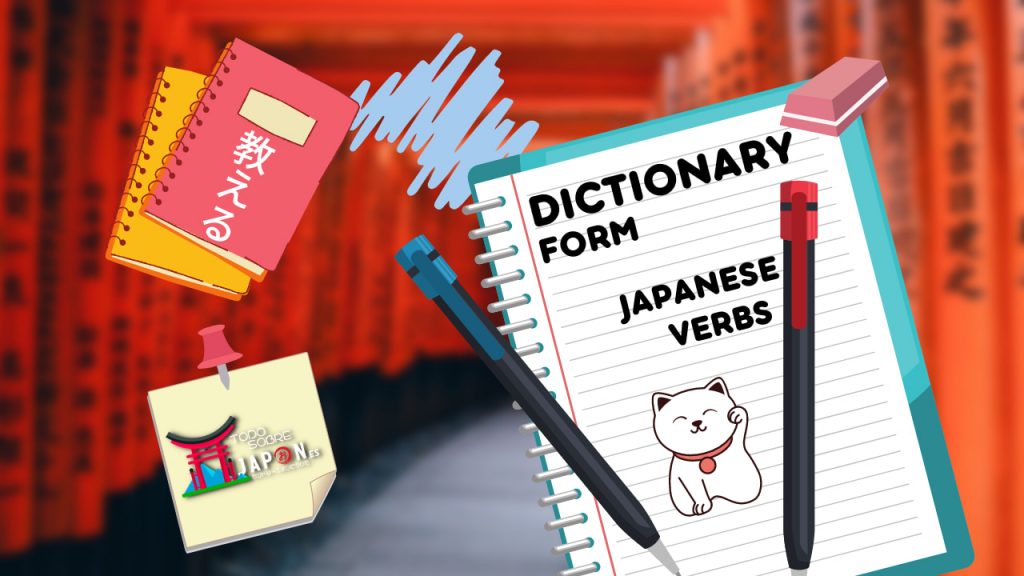Japanese verb forms: The biggest difficulty we Westerners have when learning Japanese is that it is a language different from Spanish or English or other Western languages.
But not all the news was going to be bad news for students, as Japanese has a very simple way of working with verbs.
Here are the basic rules that Japanese verbs follow, paying attention is very important:
– Japanese verbs do not have singular/plural conjugation or gender conjugation such as masculine or feminine.
– Japanese verbs always come at the end of a sentence.
– There are only 2 basic verb tenses: past and present. The end of a future action is indicated by the verb in its present tense.
– There are only 2 irregular verbs and little irregularity in other verbs.
What verb forms exist in Japanese | What are the Japanese verb forms like?
In Japanese there are four basic verb forms which are the “Dictionary Form”, the “Masu Form”, the “Nai Form”, and the “Te Form”, with which most actions can be expressed.
In this article we will talk about the “Dictionary Form” and the “Masu Form”.
The Japanese Dictionary Form 辞書形 | What is the Japanese dictionary form like?
The dictionary form is the verb form found in a dictionary. You could say that it is similar to the “infinitive” in Spanish.
The dictionary form always ends in the vowel u. Let’s look at some examples:
| 買う | かう | kau | buy |
| 開く | あく | aku | open |
| 行く | いく | iku | go |
| 見る | みる | miru | see |
What are the 3 Japanese verb groups |JLPT N5 Verb List
Japanese verbs are usually classified into three types: Group 1, Group 2 and Group 3.
Group 1: Here we find all verbs with the dictionary form ending in one of the following 9 syllables: Within this group are all verbs whose dictionary form ends in one of the following 9 syllables: う (-u), る (-ru), つ (-tsu), く (-ku), ぐ (gu), す (-su), ぬ (nu), む (mu), ぶ (bu).
The most common Japanese verbs in group 1 are:
| KANJI | HIRAGANA | MEANING |
|---|---|---|
| 会う | あう(au) | be found at |
| 言う | い う (iu) | say |
| 売る | うる (uru) | sell |
| 選ぶ | えらぶ (erabu) | choose |
| 泳ぐ | およぐ (oyogu) | swim |
| 遊ぶ | あそぶ (asobu) | play |
| 急ぐ | いそぐ (isogu) | hurry up |
| 脱ぐ | ぬぐ (nugu) | take off your clothes |
| 消す | けす (kesu) | turn off |
| 乗る | のる (noru) | ride / climb |
| 買う | かう (kau) | buy |
| 聞く | きく (kiku) | listen |
| 読む | よむ (yomu) | read |
| 座る | すわる (suwaru) | sit |
| 持つ | もつ (motsu) | have / carry |
| 待つ | まつ (matsu) | wait |
| 立つ | たつ (tatsu) | stand up |
| 書く | かく (kaku) | write |
| 死ぬ | しぬ (shinu)* El único verbo que acaba en nu | die |
| 歩く | あるく (aruku) | walk |
| 話す | はなす (hanasu) | speak |
| 貸す | かす (kasu) | provide |
| 飲む | のむ (nomu) | drink |
| 休む | やすむ (yasumu) | rest |
| 呼ぶ | よぶ (yobu) | call |
Group 2: Here we will find verbs with their dictionary form ending in “-iる(-iru )” or “-eる ( -eru)”.
The most common verbs in group 2 are:
| KANJI | HIRAGANA | MEANING |
|---|---|---|
| ——- | あげる (ageru) | gift / give |
| ——- | いる (iru) | to be / to have |
| 教える | おしえる (oshieru) | teach |
| 起きる | おきる (okiru) | get up |
| 借りる | かりる (kariru) | borrow |
| 食べる | たべる (taberu) | eat |
| 見る | みる (miru) | see |
However, it should be noted that some of the verbs ending in these endings belong to group 1, they are exceptions. What does it mean that they are an “exception”? It means that despite ending in 〜いる or 〜える they are inflected as group 1 verbs:
For example:
- 入る (はいる hairu) enter
- 走る (はしる hashiru) run
- 減る (へる heru) decrease
- 知る (しるshiru) know / know how
- 帰る (かえる kaeru) back to
- 切る (きる kiru) cut
- 蹴る (ける keru) kick
Group 3: Here we find the “irregular” verbs, but there are only two verbs: 来る (くる kuru) come, する (する suru*) make.
- In the case of “Suru ” it is usually part of two-word verbs such as 勉強する (benkyoo suru) study o 旅行する (ryokoo suru) travel.
Dictionary Form Summary
– Normally verbs ending in -iru or -eru are group 2, as we saw there are exceptions that belong to group 1.
– Group 3 is formed by the verbs “kuru” (to come) and “suru” (to do).
IF YOU WANT TO STUDY JAPANESE WE HAVE GROUPS IN DIFFERENT NETWORKS:
- TELEGRAM
- WHATSAPP (filter group to avoid spam), then you will be added to the groups of beginners, N5, N4 or N3, kanji, calligraphy or study material, whatever you ask for.
JAPANESE VERB EXERCISES | INTERACTIVE JAPANESE VERB EXERCISES
Here below this sentence you have the self-correcting interactive exercise online. Click on correct answers, don’t click on send to the teacher, I can’t look at everything you send.
And here you have it:
IF YOU WANT THIS FORM TO PRINT DOWNLOAD IT HERE: A window will open in adfly with advertising, you must wait 5 seconds and hit skip advertising at the top right. If it doesn’t work leave me a comment or if you are in the Japanese group or telegram send me a private message.
IF YOU WANT TO SIGN UP FOR THE NAI WAY DOWNLOAD HERE: A window will open in adfly with advertising, you must wait 5 seconds and hit skip advertising at the top right. If it doesn’t work leave me a comment or if you are from the Japanese or telegram group send me a private message.
INTERACTIVE EXERCISES ON JAPANESE VERBS DICTIONARY FORM OR JISHO FORM
Here below this sentence you have the self-correcting interactive exercise online. Click on correct answers, don’t click on send to the teacher, I can’t look at everything you send.
And here you have it:
IF YOU WANT THIS CARD TO PRINT DOWNLOAD IT HERE. A window will open in adfly with advertising, you must wait 5 seconds and hit skip advertising at the top right. If it doesn’t work leave me a comment or if you are from the Japanese or telegram group send me a private message.
You may be interested in JLPT N5:
- Lista de los 100 kanji + ejercicios
- Prueba de Ejercicios interactivos hiragana 1
- List of fruits in Japanese + exercises
- List of animals in Japanese + exercises
- Vocabulario sobre cosas de baño en japonés







